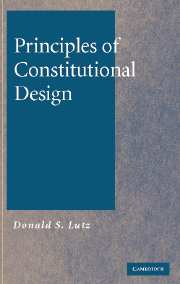Book contents
- Frontmatter
- Contents
- Preface
- Acknowledgments
- Principles of Constitutional Design
- 1 Constitutionalism: An Initial Overview and Introduction
- 2 Sovereignty
- 3 Popular Sovereignty
- 4 The Separation of Powers
- 5 Analyzing the Interaction between Popular Control and the Separation of Powers in the Amendment Process
- 6 Matching a Government to a People
- 7 An Overview of the Constitutional Design Project
- 8 An Underlying Constitutional Logic: Rational Actors?
- Index
6 - Matching a Government to a People
Published online by Cambridge University Press: 29 July 2009
- Frontmatter
- Contents
- Preface
- Acknowledgments
- Principles of Constitutional Design
- 1 Constitutionalism: An Initial Overview and Introduction
- 2 Sovereignty
- 3 Popular Sovereignty
- 4 The Separation of Powers
- 5 Analyzing the Interaction between Popular Control and the Separation of Powers in the Amendment Process
- 6 Matching a Government to a People
- 7 An Overview of the Constitutional Design Project
- 8 An Underlying Constitutional Logic: Rational Actors?
- Index
Summary
Some Initial Considerations
Constitutionalism and constitutional design are not defined by some set of principles that can be listed, memorized, and then mechanically applied. Nor are they to be discovered through some straightforward logical technique such as that based on rational-actor analysis. Constitutionalism and its attendant design principles have resulted from a centuries-old discussion aimed at understanding how to marry justice with power; how to blend hopes for a better future with the realities of the present; how to construct an order that takes into account human irrationality as well as rational actors; and how to recognize principles that are useful everywhere despite the inevitable diversity among successful political systems. If we are to understand constitutional design, then, it is essential that we reprise some of that conversation for the simple reason that the project does not rest as much on a set of principles as it rests on the reasoning implicitly contained in those principles. That is, constitutionalism and constitutional design rest on a way of looking at the world and on a method of thinking that proceeds from that perspective. The principles are thus important to us primarily to the extent they help us produce a constitutional perspective, and to achieve this perspective it is extremely useful to consider what has been rejected as well as accepted by earlier thinkers who together discovered and developed constitutional thinking.
- Type
- Chapter
- Information
- Principles of Constitutional Design , pp. 183 - 208Publisher: Cambridge University PressPrint publication year: 2006



